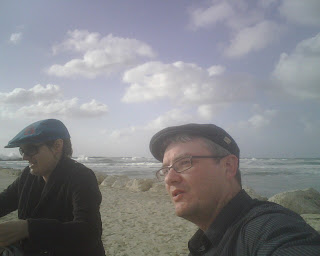Slichot Shock

(Photo note: This was the view fom where he had a Shacharit prayer service which took place directly after the stroy recounted below.)
I had one of the most profound Jewish experiences of my life last week. Last Tuesday the Jewish month of Elul passed from expectation to reality, and in celebration of this milestone, the Cantorial, Educational, and Rabbinical students participating in HUCs Year in Jerusalem program met at 4 am (yes, really, we did) to hop in buses to travel to a Sephardic Synagogue on French Hill and attend a Slichot service.
Now I do realize that a few things need to be defined for my non-Jewish friends reading this. First of all, the month of Elul is the month directly preceding the Jewish High Holy Days and takes on special significance for anyone observing even a baseline of Jewish tradition. Elul is a month of introspection. Sandra likes to say that Elul is the Jewish version of the forth step (we made a searching inventory of ourselves) of the “12 steps” of AA and other like organizations. In the month of Elul, we are encouraged to make such an inventory and then, here’s the key, do something about it. In Jewish tradition, for example, we are taught that “G-d cannot forgive us for a sin we have committed against another human – only that human can.” I have always found the human practicality of this tradition to be a beautiful guide towards Tikkun Olam – the healing of the world. We have responsibility for our own transgressions against others. Amen.
So in some Jewish traditions, folks gather at early hours to pray special prayers that focus the prayerful towards this ideal of Elul. The 13 attributes of G-d are recited interspersed with various prayers of penitence and introspection.
In Sephardic tradition, one of the things I have always enjoyed is the jazz-like quality of the service. Certain prayers that do not require a Chazzan (cantor) are passed around the community – those chanting the prayers embellish and improvise and then pass the prayers back to the Chazzan or to whomever had taken lead on a particular prayer. With the Iraqi melodies which dominated this gathering, not to mention the delicious sweet tea passed out to the weary-eyed, many of us forgot the early hour and immersed ourselves in the prayer.
Of course there is a catch. The Siddur (prayerbook) was of course unfamiliar to most of us and many of the prayers went by at breakneck speed which meant that on any given prayer we would mostly be lucky to be on the right page let alone follow along at the right word. Which was why when the Chazzan, during one of these prayers, turned around and pointed at me to sing, my limbs turned to hummus. With the exception of (the brilliant) Cantor Schleifer from HUC, only members of this synagogue participated in the Jazz. I am not sure why the Chazzan turned to me. I had been, truth be told, lost more than 50% of the service, frenetically turning pages to try to do my usual “Aha – there is the word ‘Israel’ on this page – when I hear ‘Israel’ then I will know we are here . . .”
All of my music teachers, especially in this case Jazz professors—thank you. I am sure that what emerged from my mouth was not exactly a thing of great cantorial beauty, but in one of the more terrifying and exhilarating moments of my religious life I chanted for a while in an Iraqi mode and then passed the tune back to the Chazzan.
I’d like to make some sort of amazing metaphor out of the experience—perhaps that some universal reality gave me an opportunity to represent my school and my peers in a positive way when Reform Judaism is, to say the least, not usually accepted—perhaps my love of the music and prayer that I was hearing so exploded from my spirit that the Chazzan sensed something that needed release and allowed the opportunity. Perhaps it was truly random and had no meaning other than “one of our guests should be heard.” I do know, however, that something in me is different since then. In choir and in voice lessons I sing with more confidence than ever in my life and I have started making strides I would have never imagined. I know as well that there has been something new in my prayer life since then – more than once I have found myself overwhelmed by words that days before seemed only commonplace and have wrapped myself some moments in my Tallis and wept for that which words cannot describe.
I have for years said that the power of Jewish prayer is three-fold (all of which I will explore in much more detail at some other time): To connect the community with and through a common expression, to connect those praying to a literal and historic tradition, and to allow a, dare I say, Zen-like focus to bring the confusion of living in every direction (except the present) into the present and allow the I-healing and I-focus that must exist before the “I” can ever hope to be of use to the other half of divine self, the “Thou.” But I think I must rethink. Here I am a mystic at heart that seems to have discounted a fourth truth – the mystical “reality” that the prayer is the beginning (or at least the outward expression) of a movement from one holy vessel of creation and partnership with G-d into the greater community of creation and partnership with G-d. Maybe prayer . . . works.
A meaningful Elul to you all.

Comments
I know, I know- your copious free time, eh?
Cheers my friend.
Scott.
http://www.thisisby.us/index.php/content/the_time_i_helped_some_jews
Hope all is well on your end Pauley!
Scott.